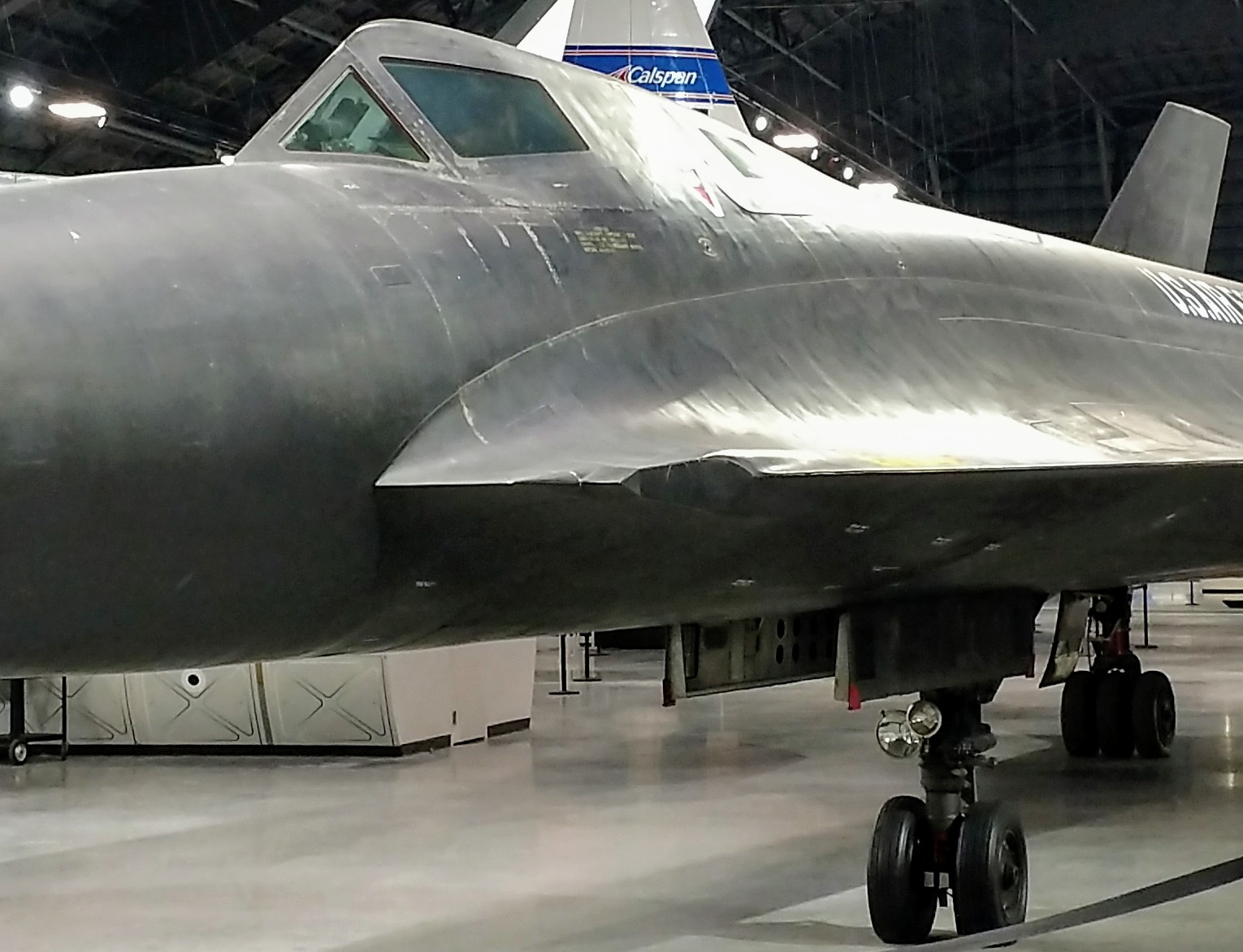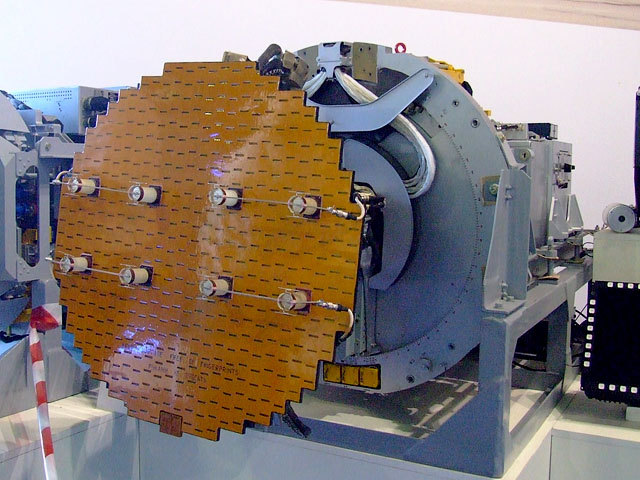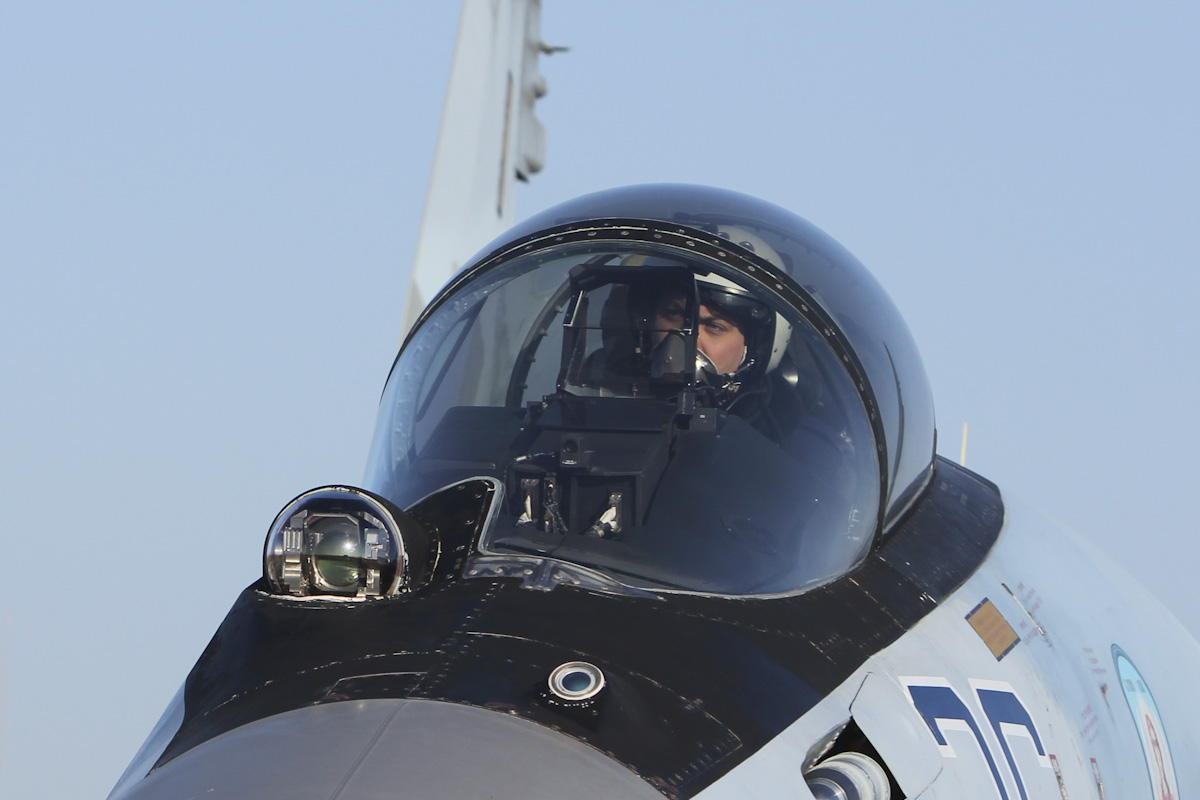|
ASG-18
The Hughes AN/ASG-18 Fire Control System was a prototype airborne fire control radar system for the planned North American XF-108 Rapier interceptor aircraft, and the Lockheed YF-12 for the United States Air Force. It was the US's first Pulse-Doppler radar A pulse-Doppler radar is a radar system that determines the range to a target using pulse-timing techniques, and uses the Doppler effect of the returned signal to determine the target object's velocity. It combines the features of pulse radars an ..., giving it look-down/shoot-down capability, and was also the first track while scan radar (could track one target at a time). This was paired with an infrared search and track (IRST) system. Range of the radar was estimated at between 200 and 300 miles (322 to 482 km), with reliable detection of bomber-sized targets at 100 miles. The installation itself was massive, weighing 2,100 lb (953 kg), and taking up most of the nose of the aircraft. The system was to be ... [...More Info...] [...Related Items...] OR: [Wikipedia] [Google] [Baidu] |
North American XF-108 Rapier
The North American XF-108 Rapier was a proposed long-range, high-speed interceptor aircraft designed by North American Aviation intended to defend the United States from supersonic Soviet strategic bombers. The aircraft would have cruised at speeds around with an unrefueled combat radius over , and was equipped with radar and missiles offering engagement ranges up to against bomber-sized targets. To limit development costs, the program shared engine development with the North American XB-70 Valkyrie strategic bomber program, and used a number of elements of earlier interceptor projects. The program had progressed only as far as the construction of a single wooden mockup when it was cancelled in 1959, due to a shortage of funds and the Soviets' adoption of ballistic missiles as their primary means of nuclear attack. Had it flown, the F-108 would have been the heaviest fighter of its era. Prior to the project's cancellation, U.S. President Dwight D. Eisenhower noted that ra ... [...More Info...] [...Related Items...] OR: [Wikipedia] [Google] [Baidu] |
Lockheed YF-12
The Lockheed YF-12 was an American Mach 3+ capable, high-altitude interceptor prototype, developed and manufactured by American aerospace company Lockheed Corporation. It was developed during the late 1950s and early 1960s as a potential replacement for the F-106 Delta Dart interceptor for the United States Air Force (USAF). The YF-12 was a twin-seat version of the then-secret single-seat Lockheed A-12 reconnaissance aircraft operated by the Central Intelligence Agency (CIA); unlike the A-12, it was furnished with the Hughes AN/ASG-18 fire-control radar and could be armed with AIM-47 Falcon (GAR-9) air-to-air missiles. Its maiden flight was on 7 August 1963. Its existence was publicly revealed by President Lyndon B. Johnson on 24 February 1964; this move was to provide plausible deniability for the CIA-operated A-12 fleet, which closely resembled the prototype YF-12. During the 1960s, the YF-12 underwent flight evaluations by the USAF, but funding to put it into oper ... [...More Info...] [...Related Items...] OR: [Wikipedia] [Google] [Baidu] |
AIM-47 Falcon
The Hughes AIM-47 Falcon, originally GAR-9, was a very long-range high-performance air-to-air missile that shared the basic design of the earlier AIM-4 Falcon. It was developed in 1958 along with the new Hughes AN/ASG-18 radar fire-control system intended to arm the Mach 3 XF-108 Rapier interceptor aircraft and, after its cancellation, the YF-12A. It was never used operationally, but was a direct predecessor of the AIM-54 Phoenix. Development Development for XF-108 In the early 1950s, the United States Air Force developed requirements for a high speed, high performance interceptor aircraft, originally called the LRI-X. In 1957, Hughes won the contract to supply the weapons system for this aircraft. This system consisted of the GAR-X missile and the YX-1 radar and fire control system. The original missile design had a range of 15 to 25 miles (25 to 40 km), and could be equipped with a conventional warhead or a 0.25 kiloton version of the W42 nuclear warhead. When the North ... [...More Info...] [...Related Items...] OR: [Wikipedia] [Google] [Baidu] |
Look-down/shoot-down
A radar system has look-down/shoot-down capability if it can detect, track and guide a weapon to an air target that (as seen by the radar) is silhouetted against the ground. Problem and naming Airborne intercept radar relying exclusively on time domain radar techniques is effectively blind any time the radar's antenna is aimed towards the Earth's surface. That is because pointing the radar at the ground produces a large reflection. That reflection and the ensuing "cluttered" display overwhelms human operators and computing systems (see ground clutter). Radar systems of this type are essentially useless when pointed ‘down’ at the surface, with the zone of weakness near and below the horizon. This zone can be actively utilized by enemy combatants wishing to hide from radar tracking utilizing a technique known as terrain masking. Frequency domain signal processing combined with time domain signal processing, as in pulse-Doppler radar, is a way to eliminate that vulnerability. L ... [...More Info...] [...Related Items...] OR: [Wikipedia] [Google] [Baidu] |
Track While Scan
The track while scan (TWS) is a mode of radar operation in which the radar allocates part of its power to tracking the target or targets while part of its power is allocated to scanning, unlike the straight tracking mode, when the radar directs all its power to tracking the acquired targets. In the TWS mode the radar has a possibility to acquire additional targets as well as providing an overall view of the airspace and helping maintain better situational awareness. Background Early airborne radar systems generally operated purely as tracking systems, with a dedicated radar operator manually "tuning" the system to locate targets in a relatively narrow field-of-view in front of the aircraft. The searching area could be moved using a variety of methods, typically phase-shifting or lobe switching on lower frequency systems that required large antennas, or by moving the radar dish on microwave frequency radars. Engagements would start with ground controllers guiding the aircraft into ... [...More Info...] [...Related Items...] OR: [Wikipedia] [Google] [Baidu] |
Pulse-Doppler Radar
A pulse-Doppler radar is a radar system that determines the range to a target using pulse-timing techniques, and uses the Doppler effect of the returned signal to determine the target object's velocity. It combines the features of pulse radars and continuous-wave radars, which were formerly separate due to the complexity of the electronics. The first operational Pulse Doppler radar was in the CIM-10 Bomarc, an American long range supersonic missile powered by ramjet engines, and which was armed with a W40 nuclear weapon to destroy entire formations of attacking enemy aircraft. Pulse-Doppler systems were first widely used on fighter aircraft starting in the 1960s. Earlier radars had used pulse-timing in order to determine range and the angle of the antenna (or similar means) to determine the bearing. However, this only worked when the radar antenna was not pointed down; in that case the reflection off the ground overwhelmed any returns from other objects. As the ground moves at ... [...More Info...] [...Related Items...] OR: [Wikipedia] [Google] [Baidu] |
Convair B-58 Hustler
The Convair B-58 Hustler, designed and produced by American aircraft manufacturer Convair, was the first operational bomber capable of Mach 2 flight. The B-58 was developed during the 1950s for the United States Air Force (USAF) Strategic Air Command (SAC). To achieve the high speeds desired, Convair chose a delta wing design used by contemporary fighters such as the Convair F-102. The bomber was powered by four General Electric J79 engines in underwing pods. It had no bomb bay: it carried a single nuclear weapon plus fuel in a combination bomb/fuel pod underneath the fuselage. Later, four external hardpoints were added, enabling it to carry up to five weapons. The B-58 entered service in March 1960, and flew for a decade with two SAC bomb wings: the 43rd Bombardment Wing and the 305th Bombardment Wing. It was considered difficult to fly, imposing a high workload upon its three-man crews. Designed to replace the subsonic Boeing B-47 Stratojet strategic bomber, the B-58 bec ... [...More Info...] [...Related Items...] OR: [Wikipedia] [Google] [Baidu] |
Fire Control Radar
A fire-control radar (FCR) is a radar that is designed specifically to provide information (mainly target azimuth, elevation, range and range rate) to a fire-control system in order to direct weapons such that they hit a target. They are sometimes known as targeting radars, or in the UK, gun-laying radars. If the radar is used to guide a missile, it is often known as a target illuminator or illuminator radar. A typical fire-control radar emits a narrow, intense beam of radio waves to ensure accurate tracking information and to minimize the chance of losing track of the target. This makes them less suitable for initial detection of the target, and FCRs are often partnered with a medium-range search radar to fill this role. In British terminology, these medium-range systems were known as tactical control radars. Most modern radars have a track-while-scan capability, enabling them to function simultaneously as both fire-control radar and search radar. This works either by having the ... [...More Info...] [...Related Items...] OR: [Wikipedia] [Google] [Baidu] |
United States Air Force
The United States Air Force (USAF) is the air service branch of the United States Armed Forces, and is one of the eight uniformed services of the United States. Originally created on 1 August 1907, as a part of the United States Army Signal Corps, the USAF was established as a separate branch of the United States Armed Forces in 1947 with the enactment of the National Security Act of 1947. It is the second youngest branch of the United States Armed Forces and the fourth in order of precedence. The United States Air Force articulates its core missions as air supremacy, global integrated intelligence, surveillance and reconnaissance, rapid global mobility, global strike, and command and control. The United States Air Force is a military service branch organized within the Department of the Air Force, one of the three military departments of the Department of Defense. The Air Force through the Department of the Air Force is headed by the civilian Secretary of the ... [...More Info...] [...Related Items...] OR: [Wikipedia] [Google] [Baidu] |
Infrared Search And Track (IRST)
An infrared search and track (IRST) system (sometimes known as infrared sighting and tracking) is a method for detecting and tracking objects which give off infrared radiation, such as the infrared signatures of jet aircraft and helicopters. IRST is a generalized case of forward looking infrared (FLIR), i.e. from forward-looking to all-round situation awareness. Such systems are passive (thermographic camera), meaning they do not give out any radiation of their own, unlike radar. This gives them the advantage that they are difficult to detect. However, because the atmosphere attenuates infrared to some extent (although not as much as visible light) and because adverse weather can attenuate it also (again, not as badly as visible systems), the range compared to a radar is limited. Within range, angular resolution is better than radar due to the shorter wavelength. History Early systems The first use of an IRST system appears to be the F-101 Voodoo, F-102 Delta Dagger and F ... [...More Info...] [...Related Items...] OR: [Wikipedia] [Google] [Baidu] |
Aircraft Radars
An aircraft is a vehicle that is able to fly by gaining support from the air. It counters the force of gravity by using either static lift or by using the dynamic lift of an airfoil, or in a few cases the downward thrust from jet engines. Common examples of aircraft include airplanes, helicopters, airships (including blimps), gliders, paramotors, and hot air balloons. The human activity that surrounds aircraft is called ''aviation''. The science of aviation, including designing and building aircraft, is called ''aeronautics.'' Crewed aircraft are flown by an onboard pilot, but unmanned aerial vehicles may be remotely controlled or self-controlled by onboard computers. Aircraft may be classified by different criteria, such as lift type, aircraft propulsion, usage and others. History Flying model craft and stories of manned flight go back many centuries; however, the first manned ascent — and safe descent — in modern times took place by larger hot-a ... [...More Info...] [...Related Items...] OR: [Wikipedia] [Google] [Baidu] |
Cold War Military Computer Systems Of The United States
Cold is the presence of low temperature, especially in the atmosphere. In common usage, cold is often a subjective perception. A lower bound to temperature is absolute zero, defined as 0.00K on the Kelvin scale, an absolute thermodynamic temperature scale. This corresponds to on the Celsius scale, on the Fahrenheit scale, and on the Rankine scale. Since temperature relates to the thermal energy held by an object or a sample of matter, which is the kinetic energy of the random motion of the particle constituents of matter, an object will have less thermal energy when it is colder and more when it is hotter. If it were possible to cool a system to absolute zero, all motion of the particles in a sample of matter would cease and they would be at complete rest in the classical sense. The object could be described as having zero thermal energy. Microscopically in the description of quantum mechanics, however, matter still has zero-point energy even at absolute zero, because ... [...More Info...] [...Related Items...] OR: [Wikipedia] [Google] [Baidu] |







